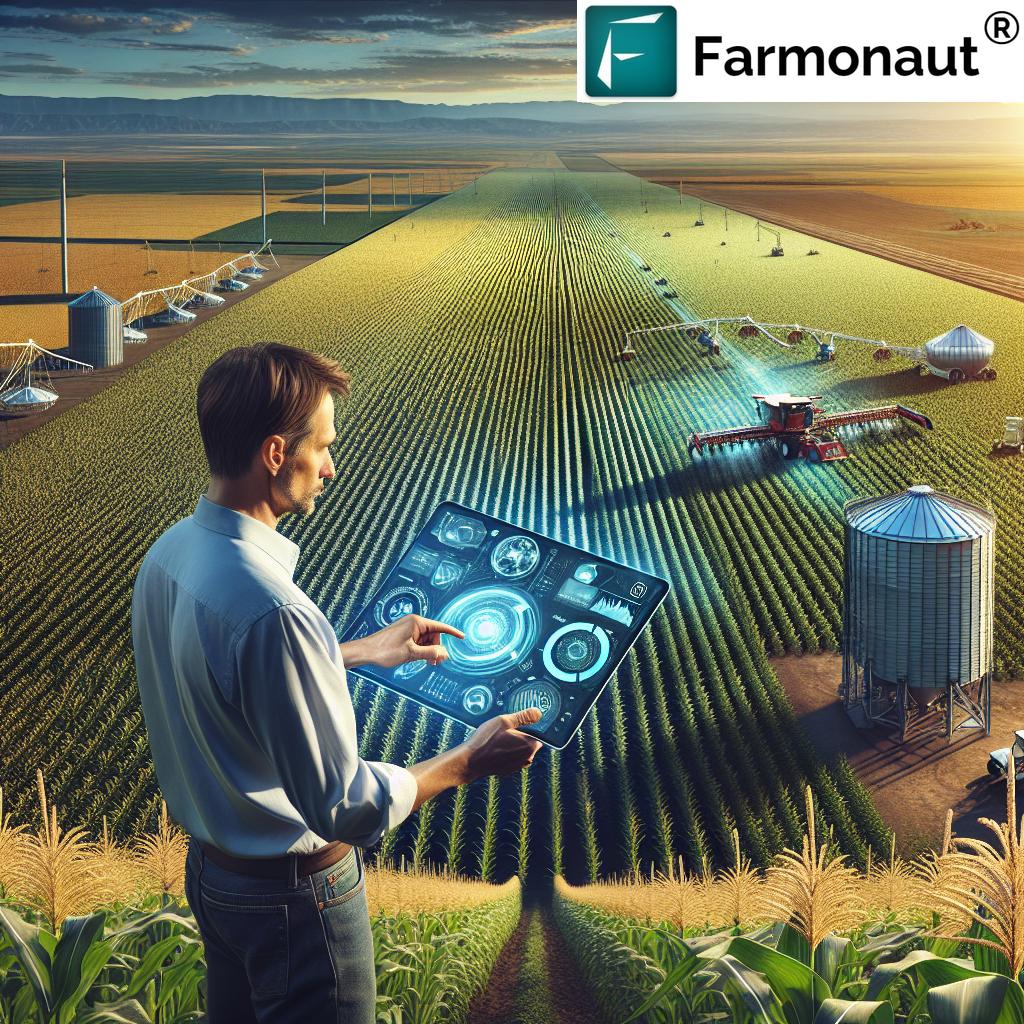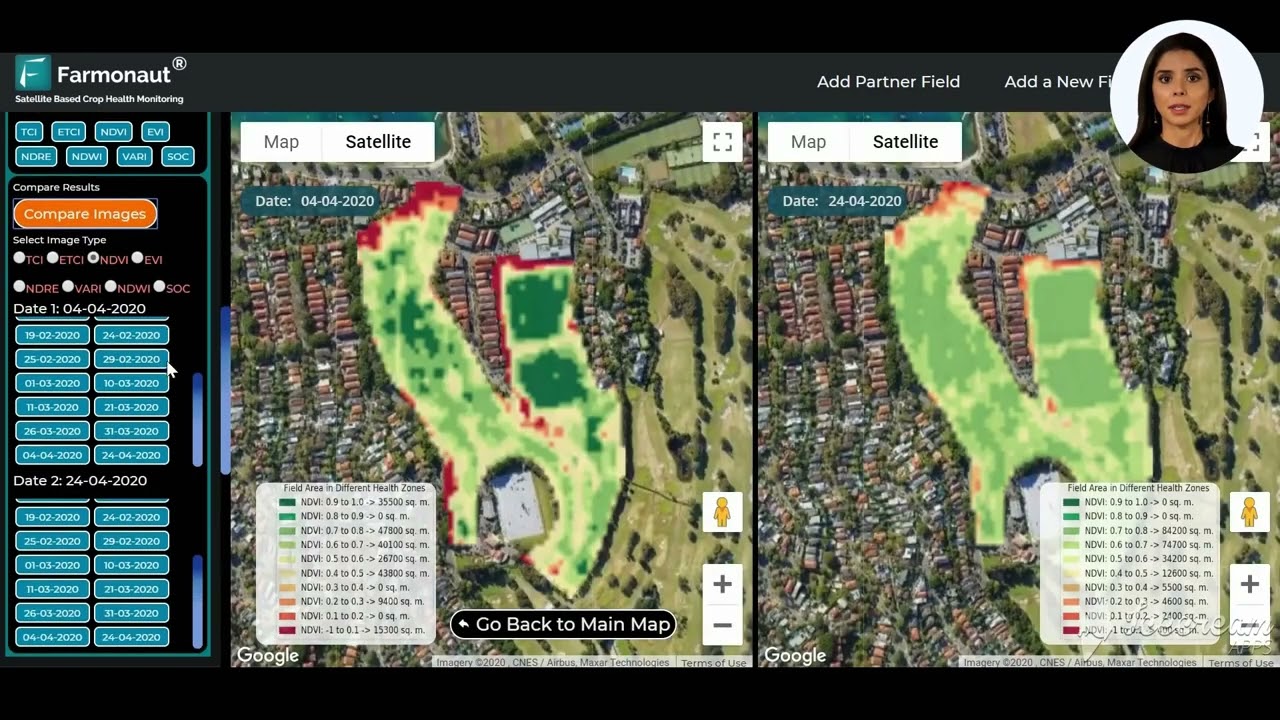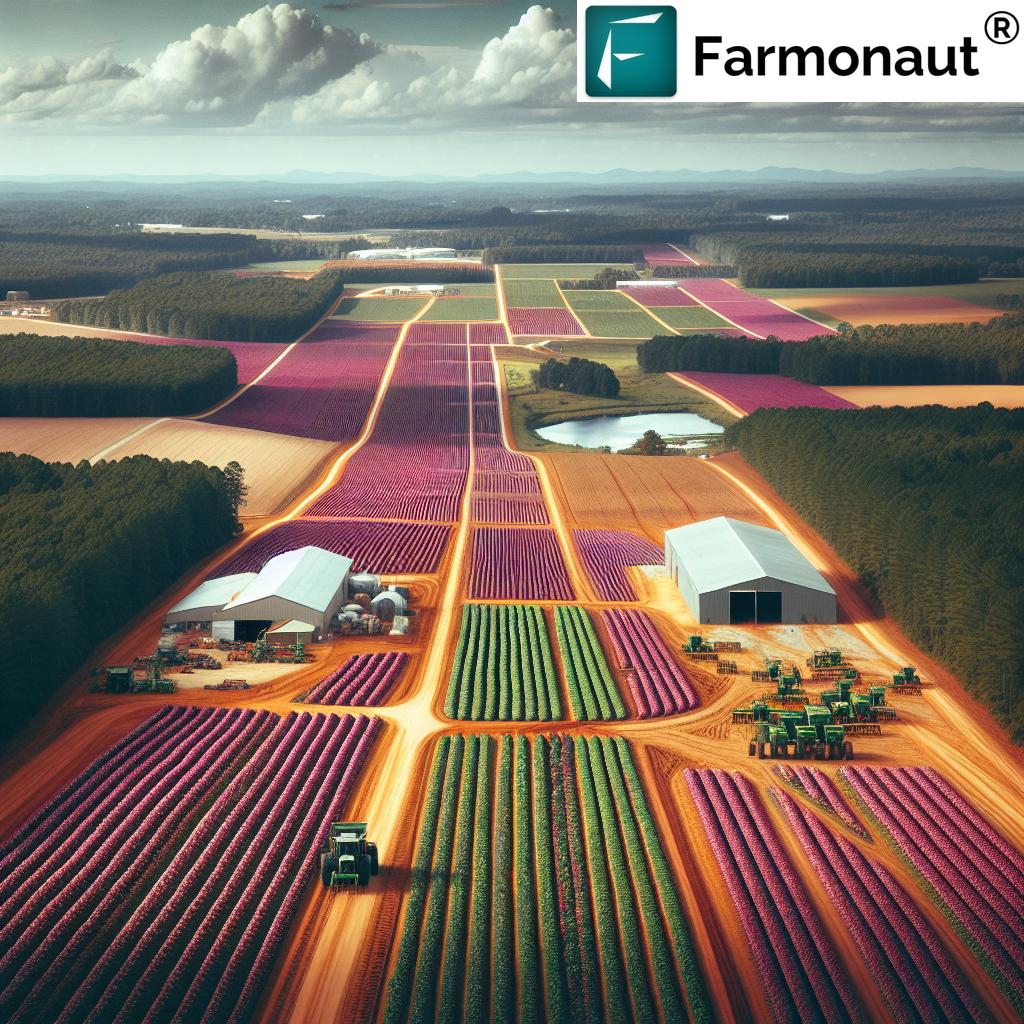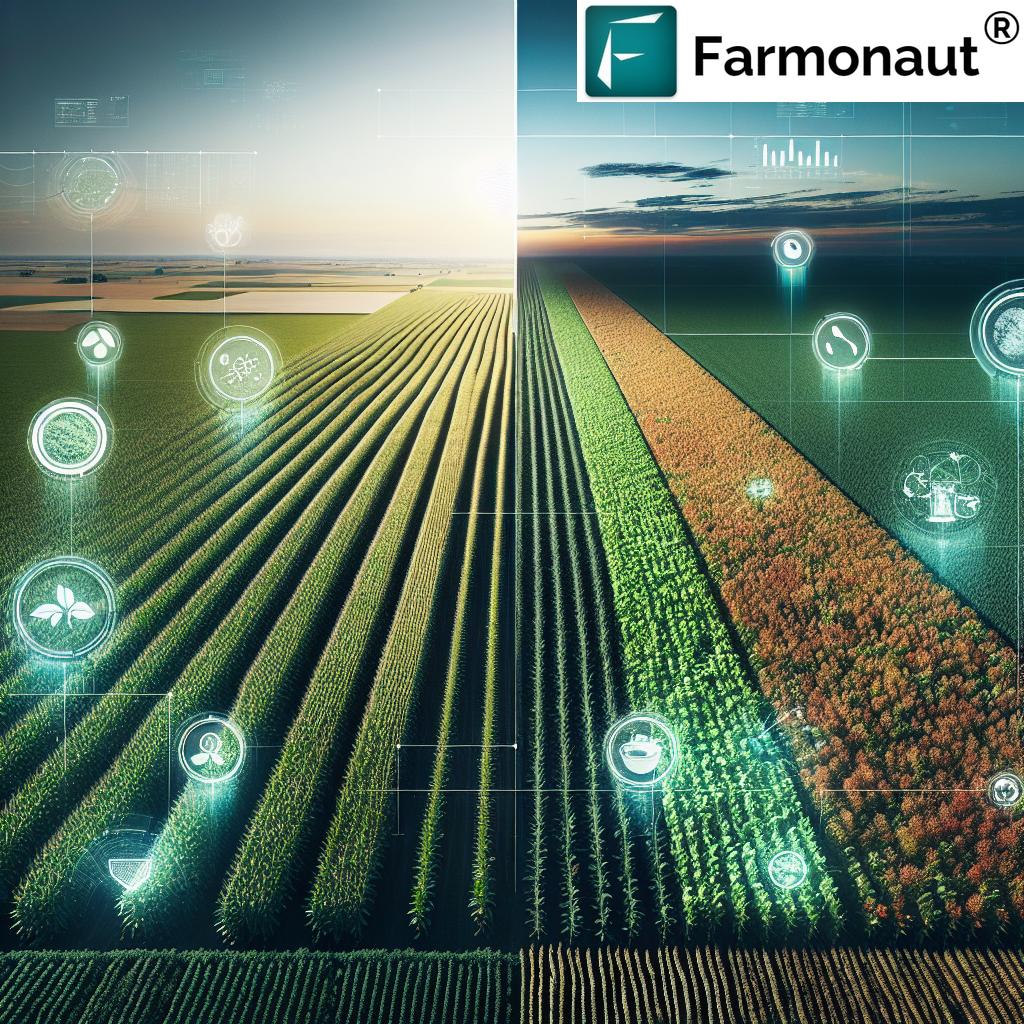Drone Ban Controversy: How US Farmers Are Fighting for Precision Agriculture Technology
“The Countering CCP Drones Act could affect over 500,000 US farms currently using precision agriculture technology.”
In the ever-evolving landscape of American agriculture, a new controversy has emerged that threatens to disrupt the delicate balance between national security and farming innovation. The proposed Countering CCP Drones Act has ignited a fierce debate, pitting concerns over foreign surveillance against the pressing need for advanced agricultural technology. As representatives of Farmonaut, a company at the forefront of satellite-based farm management solutions, we find ourselves uniquely positioned to explore the implications of this potential ban on certain drone manufacturers and its impact on the US farming industry.
This comprehensive blog post will delve into the heart of the matter, examining how US farmers are rallying to protect their access to crucial precision agriculture tools. We’ll explore the multifaceted role of agricultural drones in modern farming, the potential consequences of restrictive legislation, and the innovative alternatives that may shape the future of crop management.
The Rise of Precision Agriculture and Drone Technology
To understand the gravity of the situation, we must first acknowledge the revolutionary impact that precision agriculture and drone technology have had on farming practices in recent years. Agricultural drones have become indispensable tools for farmers across the United States, offering unparalleled advantages in crop monitoring, resource management, and overall farm productivity.
- Aerial Crop Monitoring: Drones equipped with high-resolution cameras and multispectral sensors provide farmers with detailed insights into crop health, growth patterns, and potential issues.
- Precision Spraying: Drone applications for crop management have revolutionized pesticide and fertilizer application, allowing for targeted treatments that reduce waste and environmental impact.
- Soil and Field Analysis: Advanced drones can assess soil conditions, moisture levels, and topography, enabling farmers to optimize planting strategies and irrigation systems.
- Livestock Monitoring: In the realm of animal husbandry, drones assist in tracking herd movements, detecting health issues, and managing grazing patterns.
The integration of these technologies has led to significant advancements in farming efficiency, yield optimization, and sustainable practices. As a result, the proposed ban on certain drone manufacturers has sent shockwaves through the agricultural community, prompting concerns about potential setbacks in farm equipment innovation and productivity.

The Countering CCP Drones Act: A Double-Edged Sword
At the heart of this controversy lies the Countering CCP Drones Act, a piece of legislation aimed at addressing national security concerns related to foreign-made drones. While the act’s intentions are rooted in protecting sensitive information and infrastructure, its broad scope has inadvertently caught the agricultural sector in its crosshairs.
The proposed ban would primarily affect drones manufactured by companies with ties to countries deemed potential security risks. Unfortunately, many of these manufacturers are also leaders in producing affordable and highly effective agricultural drones, which have become staples in modern farming operations across the US.
Key Points of Contention:
- National Security vs. Agricultural Needs: Balancing the imperative of national security with the practical requirements of the farming industry presents a significant challenge.
- Economic Impact: The potential ban could lead to increased costs for farmers who rely on these drones for various aspects of crop management and farm operations.
- Technological Setbacks: Limiting access to certain drone technologies may hinder advancements in precision agriculture and slow the pace of farming innovation.
- Supply Chain Disruptions: The act could disrupt established supply chains for agricultural equipment and precision agriculture tools.
As the debate unfolds, it’s crucial to consider alternative solutions that address security concerns without compromising the technological progress that has revolutionized American agriculture.
The Farmer’s Perspective: Fighting for Technological Access
Across the United States, farmers and agricultural organizations are mobilizing to voice their concerns about the potential impact of the drone ban. Their arguments center on the critical role that drone technology plays in modern farming practices and the potential consequences of restricting access to these tools.
Key Arguments from the Agricultural Community:
- Efficiency and Productivity: Drones have significantly improved farm efficiency, allowing for more precise resource allocation and quicker response to crop issues.
- Environmental Benefits: Precision agriculture enabled by drones has led to reduced use of pesticides and fertilizers, contributing to more sustainable farming practices.
- Economic Considerations: Many farmers have invested heavily in drone technology and worry about the financial implications of replacing their equipment.
- Food Security: There are concerns that limiting access to advanced farming tools could impact overall crop yields and, by extension, national food security.
“Agricultural drones can reduce pesticide use by up to 30% through targeted application in precision farming.”
This statistic underscores the significant environmental and economic benefits that precision agriculture tools, including drones, bring to the farming industry. It’s a prime example of why farmers are fighting to maintain access to these technologies.
The Role of Agricultural Remote Sensing in Modern Farming
While the drone ban controversy has brought significant attention to aerial technologies, it’s important to recognize that agricultural remote sensing encompasses a broader range of tools and techniques. At Farmonaut, we specialize in satellite-based farm management solutions that offer many of the benefits of drone technology without the associated security concerns.
Satellite-based remote sensing provides farmers with valuable data on crop health, soil conditions, and weather patterns. This information enables precise decision-making in areas such as:
- Crop Monitoring: Regular satellite imagery allows farmers to track crop growth and identify potential issues early.
- Resource Management: Data on soil moisture and vegetation health helps optimize irrigation and fertilizer use.
- Yield Prediction: Advanced algorithms can estimate crop yields based on satellite data, aiding in harvest planning and market strategies.
- Climate Adaptation: Long-term satellite data assists farmers in adapting to changing climate patterns and optimizing crop selection.
By leveraging these satellite-based solutions, farmers can continue to benefit from precision agriculture technology even in the face of potential drone restrictions.
Balancing Security and Innovation: Potential Solutions
As the agricultural community continues to advocate for access to drone technology, several potential solutions have emerged that aim to address both security concerns and the needs of farmers:
- Domestic Production: Encouraging the development and manufacture of agricultural drones within the US could alleviate security concerns while maintaining technological access.
- Certification Programs: Implementing rigorous certification processes for foreign-made drones could allow for continued use of certain models in agricultural settings.
- Data Management Protocols: Establishing strict guidelines for data collection, storage, and transmission could mitigate security risks associated with drone use.
- Hybrid Technologies: Combining satellite-based remote sensing with limited drone use could offer a compromise solution.
These approaches highlight the need for collaborative efforts between policymakers, security experts, and agricultural stakeholders to find a balanced solution that protects national interests without stifling innovation in farming.

The Future of Precision Agriculture: Adapting to Change
Regardless of the outcome of the drone ban controversy, the future of precision agriculture in the United States remains bright. The industry has consistently demonstrated its ability to adapt to regulatory changes and technological shifts. As we look ahead, several trends are likely to shape the landscape of agricultural technology:
- Increased Integration of Satellite Data: Companies like Farmonaut are at the forefront of providing comprehensive satellite-based solutions for farm management.
- Advancements in AI and Machine Learning: These technologies will continue to enhance the interpretation and application of remote sensing data in agriculture.
- Development of New Sensor Technologies: Innovations in sensor technology may lead to new methods of gathering critical farm data without relying on drones.
- Emphasis on Data Security: The industry will likely see a greater focus on developing secure data management systems for agricultural technology.
Explore Farmonaut’s API for advanced satellite-based agricultural solutions
The Impact on Various Agricultural Sectors
The potential drone ban would have far-reaching effects across different sectors of agriculture. Let’s examine how various aspects of farming might be affected:
Crop Production
Large-scale crop producers have been among the most significant adopters of drone technology. The ban could impact:
- Precision spraying of pesticides and fertilizers
- Early detection of crop diseases and pests
- Accurate yield estimations
Livestock Management
While perhaps less affected than crop production, the livestock sector still utilizes drones for:
- Monitoring grazing patterns and herd movements
- Checking fences and identifying injured animals
- Assessing pasture conditions
Horticulture and Specialty Crops
Producers of high-value crops often rely on the precision offered by drones for:
- Monitoring plant health in orchards and vineyards
- Optimizing irrigation in water-sensitive crops
- Assessing ripeness and planning harvests
Check out our API Developer Docs for integrating satellite data into your agricultural applications
Environmental Considerations
The debate surrounding the drone ban also touches on important environmental considerations. Precision agriculture, facilitated by drone technology, has been instrumental in promoting more sustainable farming practices:
- Reduced Chemical Usage: Targeted application of pesticides and fertilizers minimizes environmental impact.
- Water Conservation: Precision irrigation systems guided by drone data help conserve water resources.
- Soil Health: Accurate soil analysis leads to better management practices that preserve soil quality.
- Biodiversity Protection: Precise application of agricultural inputs helps protect surrounding ecosystems.
Any potential ban on agricultural drones must carefully consider these environmental benefits and explore how they can be maintained through alternative technologies or exemptions for agricultural use.
The Economic Implications of the Drone Ban
The potential economic impact of the proposed drone ban on the agricultural sector cannot be overstated. It’s crucial to consider both the short-term disruptions and long-term consequences:
Short-term Impacts:
- Equipment Replacement Costs: Farmers may need to invest in new, compliant technologies.
- Productivity Losses: Transitioning to new systems could temporarily reduce efficiency.
- Market Disruptions: Changes in production capabilities might affect crop yields and market supply.
Long-term Consequences:
- Innovation Slowdown: Restrictions could hamper the development of new agricultural technologies.
- Competitive Disadvantage: US farmers might fall behind global competitors who have access to advanced drone technologies.
- Shift in Farm Economics: The cost structure of farming operations may change, potentially affecting food prices.
Alternatives and Adaptations
As the agricultural community grapples with the potential drone ban, it’s essential to explore alternative technologies and adaptive strategies that can help maintain the benefits of precision agriculture:
- Enhanced Satellite Imagery: Companies like Farmonaut offer high-resolution satellite data that can replicate many functions of drone technology.
- Ground-based Sensors: Advanced IoT devices can provide detailed, localized data on soil and crop conditions.
- Manned Aircraft: Traditional crop dusting and aerial photography services may see increased demand.
- Robotics: Ground-based autonomous robots could fill some roles currently occupied by drones.
- AI and Data Analytics: Improved algorithms can enhance the utility of existing data sources, partially compensating for the loss of drone-gathered information.
These alternatives showcase the resilience and innovative spirit of the agricultural technology sector. While they may not fully replace the capabilities of drones, they offer viable paths forward for farmers committed to precision agriculture.
The Global Context: International Implications
The drone ban controversy in the US has implications that extend beyond national borders. As a global leader in agricultural production and technology, US policies can have far-reaching effects on international markets and practices:
- Trade Relations: The ban could affect agricultural trade relationships, particularly with countries that manufacture the targeted drones.
- Global Food Security: Any significant impact on US agricultural productivity could have ripple effects on global food supplies and prices.
- Technological Development: The US market has been a driving force in agricultural innovation; restrictions could slow global advancements in farming technology.
- Regulatory Precedents: Other countries may follow suit with similar bans, potentially creating a patchwork of international regulations on agricultural drone use.
As the situation evolves, it will be crucial for policymakers to consider these global implications and work towards solutions that balance national security with the needs of the international agricultural community.
The Role of Education and Training
Regardless of the outcome of the drone ban controversy, there is a clear need for enhanced education and training in the agricultural sector. As farming technology continues to evolve, ensuring that farmers and agricultural workers are equipped with the necessary skills becomes increasingly important:
- Technology Literacy: Programs to help farmers understand and utilize various precision agriculture tools, including satellite-based solutions.
- Data Management: Training on how to interpret and apply the vast amounts of data generated by modern farming technologies.
- Regulatory Compliance: Education on navigating the complex landscape of agricultural regulations and technology restrictions.
- Sustainable Practices: Workshops and courses on integrating technology with environmentally friendly farming methods.
By investing in education and training, the agricultural sector can build resilience against regulatory changes and continue to drive innovation in farming practices.
Impact of Drone Ban on US Agriculture: Pros and Cons
| Aspect | Potential Benefits | Potential Drawbacks |
|---|---|---|
| National Security | Reduced risk of foreign surveillance | Limited access to advanced precision agriculture tools |
| Farm Productivity | Encouragement of domestic technology development | Decreased efficiency in crop monitoring and management |
| Crop Management | Increased focus on alternative technologies (e.g., satellites) | Reduced ability for precise pesticide and fertilizer application |
| Production Costs | Potential long-term savings through domestic innovation | Short-term increase in costs due to equipment replacement |
| Technological Innovation | Stimulation of US-based agricultural tech sector | Possible slowdown in overall precision agriculture advancements |
The Path Forward: Collaboration and Compromise
As we navigate this complex issue, it’s clear that finding a solution will require collaboration between various stakeholders:
- Government Agencies: Balancing security concerns with the needs of the agricultural sector.
- Farmers and Agricultural Organizations: Advocating for their technological needs and proposing workable solutions.
- Technology Companies: Developing compliant technologies that meet both security and agricultural requirements.
- Research Institutions: Conducting studies on the impact of various technologies on farm productivity and national security.
The path forward likely involves a nuanced approach that may include:
- Targeted Exemptions: Allowing certain drone models or uses specifically for agricultural purposes.
- Phased Implementation: Gradually introducing restrictions to allow time for adaptation and development of alternatives.
- Investment in Domestic Technology: Government support for US-based development of agricultural drones and related technologies.
- International Cooperation: Working with allies to develop shared standards for secure agricultural technology.
Conclusion: Embracing Change in Agriculture
The drone ban controversy underscores the delicate balance between national security and technological progress in agriculture. As we’ve explored throughout this blog post, the potential impacts of such legislation are far-reaching, touching on issues of productivity, sustainability, and global food security.
While the challenges posed by the proposed ban are significant, they also present an opportunity for innovation and adaptation within the agricultural sector. Companies like Farmonaut are at the forefront of developing alternative solutions, such as advanced satellite-based farm management systems, that can help bridge the gap left by potential drone restrictions.
As the debate continues, it’s crucial for all stakeholders to remain engaged and open to creative solutions. The future of agriculture will undoubtedly be shaped by how we navigate these complex issues, balancing the need for security with the imperative of feeding a growing global population.
By fostering collaboration, investing in education, and embracing innovative technologies, the US agricultural sector can emerge from this controversy stronger and more resilient. The path forward may be challenging, but it also holds the promise of a new era in precision agriculture—one that is secure, sustainable, and incredibly productive.
FAQ Section
Q: What is the Countering CCP Drones Act?
A: The Countering CCP Drones Act is proposed legislation aimed at banning certain drone manufacturers, primarily those with ties to countries deemed security risks, from operating in the United States. This act is intended to address national security concerns but has implications for various industries, including agriculture.
Q: How do agricultural drones contribute to precision farming?
A: Agricultural drones play a crucial role in precision farming by providing high-resolution imagery for crop monitoring, enabling targeted application of pesticides and fertilizers, assessing soil conditions, and helping with yield prediction. They significantly enhance efficiency and resource management in farming operations.
Q: What are the main concerns of US farmers regarding the potential drone ban?
A: US farmers are primarily concerned about losing access to essential precision agriculture tools, potential increases in production costs, setbacks in farm equipment innovation, and the impact on overall farm productivity and sustainability practices.
Q: Are there alternatives to drone technology for precision agriculture?
A: Yes, alternatives include satellite-based remote sensing (like services offered by Farmonaut), ground-based sensors, manned aircraft for aerial applications, and advanced data analytics. While these may not fully replicate all drone functions, they offer viable alternatives for many precision agriculture needs.
Q: How might the drone ban affect global agricultural markets?
A: The ban could potentially impact US agricultural productivity, affecting global food supplies and prices. It may also influence international trade relationships, especially with countries that manufacture the banned drones, and could set precedents for similar regulations in other countries.
Q: What steps can farmers take to prepare for potential drone restrictions?
A: Farmers can explore alternative technologies like satellite-based solutions, invest in training for new technologies, engage with policymakers to voice their concerns, and stay informed about developing regulations and technological alternatives in the precision agriculture space.




















